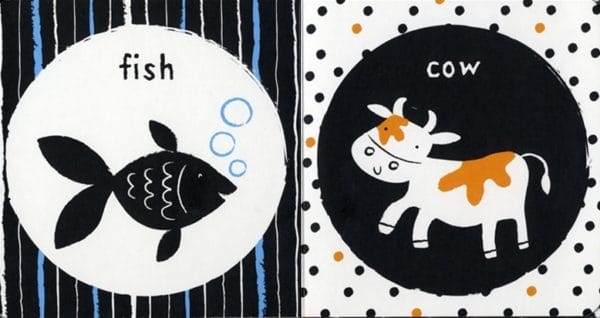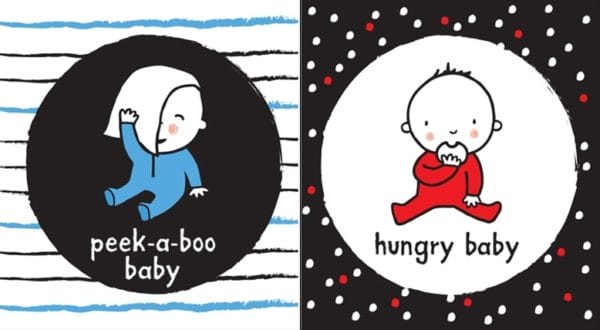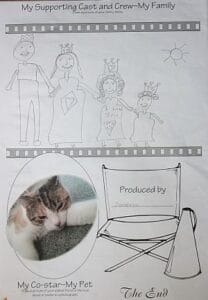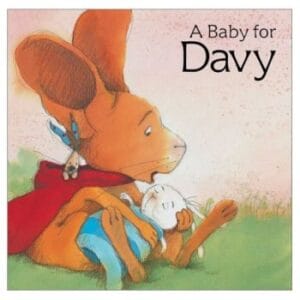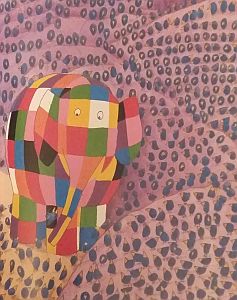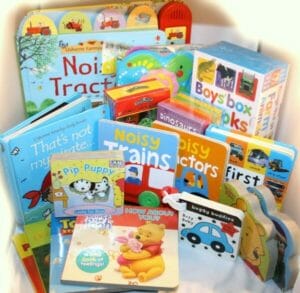Books for Babies: High-Contrast Books

As a book enthusiast, when someone has a new baby, instead of the usual baby gifts, I buy them high-contrast baby books.
Yes, they may seem boring to us adults and you may wonder why we give them to our kids. Well, I’m going to tell you!
Imagine you are a baby, (not hard for everyone to imagine, I’m sure!), and you have just entered this wonderful world full of shapes, colour, light and sounds. There is so much to see and too much to absorb.
As babies’ brains don’t quite work like adult brains do, all this stimuli is overwhelming. High- contrasting images and shapes are designed to hold the attention of a baby. They provide the baby with something to focus on and during this period of high concentration, they allow their minds to rest.
There are tonnes of research about using high-contrasting shapes and images with babies. Starting back in the early 1960s, research has shown that new-borns prefer to look at black and white geometric shapes, rather than bright colours or pastels.
Black and white is the most preferred colours because of the way a baby’s eyes develop. I won’t go into the science here but, it seems that baby’s eyes have not matured enough for them to perceive the values and intensities of red, blue, pink, yellow, purple, and green.
Babies seem to be fascinated by the contrast in black and white until they are around 6 to 9 months of age.
What I found fascinating is that babies will actually spend more time looking around at their environment after they have been shown high-contrasting images – circles being the easiest as they do not have to navigate their sight around any corners.
Will have to get some new mums to try this out!
So, what do new-borns actually see when they are born? You may notice after you have your little bundle of joy that they are unable to focus on your face properly until you come quite close to them.
This is because they do not see clearly beyond 13 inches of their face, so you are just one big blur!
They can follow objects from left to right at the same distance too and you will find that they will fix their gaze to the object. And if you show them a book or image, you will find your little one looks for the edge of figures for contrast between shape and background.
You will be surprised to know that they can already perceive depth and 3D objects! Pretty smart aren’t they?
By the age of two months, your baby’s vision has matured enough for them to be able to focus at 20 inches and by three months, this has matured to 10 feet and they have developed both near and far vision. Clever babies!
The use of high contrast books can help your child to increase their attention span. In brief, allowing your child to fixate their sight on a high contrast image could mean that they increase their fixation time and increase attention span from 10 seconds to around 60 to 90 seconds.
That’s a big improvement and there are plenty of people in white coats who have proven this to be true!!
If you want to help your baby and kick start their learning journey, try getting close to your baby’s face.
They love to explore faces, but especially if it’s mummy or daddy’s face. You could also try some of our high contrast books.
If you have found this blog useful, we would love to hear from you. Happy reading!
From our Range of High-Contrast Books
See our Range of Books for BabiesJoin our mailing list
Sign up to our Emailing List & Get the Latest Information and Offers on Resources
Thank you for joining !
Something went wrong.

